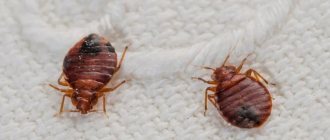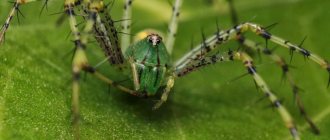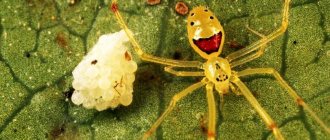Rules for keeping tarantula spiders at home
As mentioned above, spiders are found in regions with hot climates. This must be taken into account when keeping individuals at home. Among the most important points to pay attention to when placing an animal are the following:
- The pet must move freely around its home, so it needs to choose a spacious container.
- Tarantula spiders love warmth, but bright sunlight harms them. Place your pet in a warm and dark place in the house, and do not forget about the humidity of the room.
- It is necessary to monitor the behavior of individuals; outbreaks of aggression between young and adult pets often occur. Throughout life, there are several key moments, which include periods of reproduction and the emergence of the younger generation. To avoid cannibalism, adult pets should be transplanted from young animals in a timely manner.
- The animal often sheds and pollutes its home; it is necessary to periodically clean the terrarium, as well as change the soil to maintain optimal living conditions.
What should a spider's home be like?
Animals may experience stress when moving from their natural habitat, so choosing a new home is key when it comes to pet placement. When choosing a habitat, pay attention to the following parameters:
- A terrarium or aquarium is perfect for creating an artificial habitat, and there should be enough space for your pet. It is necessary to take into account the size of the individual and take a terrarium with a wall that is twice the length of the animal’s body.
- For underground species, soil at the bottom of the container is suitable; its thickness should be at least 5 cm, and soft and hard layers of soil can be combined. For those individuals that lead a terrestrial lifestyle, you will have to additionally install a snag or a small log in the aquarium. Spiders will crawl along this snag and also weave webs on it.
- An equally important issue is maintaining climatic conditions. The pet's habitat should be warm, the temperature should not be lower than 25 °C. But at the same time, it is better to hide the aquarium from direct exposure to sunlight.
Nutrition
The tarantula spider at home feeds on beetles, cockroaches, earthworms and beetle larvae. Feeding insects are specially grown to feed arthropods. Young animals are given zofobas or darkling beetle larvae; They are popularly called mealworms.
The length of the larva should correspond to 1/3 of the size of the abdomen. If after feeding it does not increase in size, then the individuals are given more food. A sign that the tarantula has eaten is an enlarged abdomen. After molting, adult spiders are given the same soft food as young ones.
At home, the tarantula is fed with darkling beetle, zofobas, Madagascar, Argentine, and Turkmen cockroaches. He can catch a cricket, a grasshopper, a locust, a small lizard. Animals love to hunt them. Insects are placed in a terrarium alive. The remaining feed is removed so that it does not rot.
Care for tarantula spiders is minimal. It is important for them to provide warmth, moist air and soil, and good ventilation. Feeding is carried out once a week. The young are given food every 3 days.
It is recommended to clean the bedding from feces and food residues. To do this, the tarantula is moved to another container. The soil is heated in a frying pan. You must handle the animal with great care.
Cleaning and cleaning, hygiene
Correct and high-quality soil poured into the terrarium is very important . Good soil helps maintain optimal moisture levels. You can choose the soil yourself quite easily. Such a substrate must have good air permeability. Among other things, the soil must be as clean as possible to prevent the development of putrefactive microflora and mold. The optimal substrate is one with sufficient moisture content, but not too fine.
To make the substrate sufficiently moist, it is necessary to regularly wet the soil with clean water at room temperature. Excessive waterlogging and insufficient soil moisture inside the terrarium are unacceptable, and often become the main cause of death or death of a pet. Hygienic cleaning of the walls and bottom of the terrarium should be carried out as it gets dirty. It is also possible to partially replace the substrate.
This is interesting! Experienced owners of tarantula spiders recommend adding coconut substrate to the bottom of the terrarium, which has all the characteristics necessary for keeping arthropods at home.
House spider tarantula for beginners
As a rule, large spiders are found in the tropics, where the climate is constantly warm and humid. Some species prefer to live in the ground, where they build entire labyrinths, as well as in trees, constructing huge trapping nets. Often, the habitat of some species depends on age: at a young age they are found in the thickness of the earth, and as they grow older they move to trees or plants.
It is important to know! When keeping the tarantula spider at home, conditions should be created that are close to natural. To do this, before purchasing it, you need to study the features of the environment in which they prefer to live. If this is not done, the animal will quickly die from stress.
You should always remember that these spiders are poisonous, despite the fact that they have a peaceful nature and do not show aggression. For beginners, we can recommend the following types:
- Brachypelma Albopilosum (Brachipelma Albopilosum) leads a terrestrial way of life and is distinguished by the most calm behavior. The body size, which has a pinkish-brownish color, reaches about 16 cm. The spider bites painfully, but its bite does not pose a danger to humans. Females can live about 20 years, while males live only 3 years. It is unpretentious in care, and the diet is based on small insects. Can weave a web, although not a large one.
- Avicularia Versicolor prefers to live in trees. Adults are distinguished by their bright colors, with a predominance of blue-blue tones. The body length is about 5 cm, and together with the paws - 16 cm. It weaves a huge web, making a hole out of it for itself and securing it under the ceiling of the terrarium. It leads a nocturnal lifestyle, and during the daytime it stays in its shelter. It moves quite quickly, so it is very difficult to catch it. Females can live for about 8 years, while males can live for only a couple of years. Although the spider is poisonous, its poison is not dangerous to humans. You can pick up the spider without any problems, since its hairs do not contain toxic components.
For professionals, the species “Lasiodora Parahybana”, “Grammostola”, “Acanthoscurria” are suitable. The Goliath tarantula is considered a real decoration of any collection, and is also one of the most beautiful spiders in the world. Reaches a length of about 28 centimeters.
Spider - tarantula - the kindest female walks, eats and gives a paw!))
Reproduction
The sex of a tarantula spider is easy to determine if you follow the recommendations of experts. Young spiders begin to molt after about a month. After molting, the skin is taken and carefully examined. In the posterior region of females there is a depression, and in males there are something like two tubercles. If the individuals are adults, then the sex can be determined by appearance. Males have slightly slimmer legs and are taller, while the body is significantly smaller in size than the female.
After mating, the eggs develop inside the female for 2 months. During this period, she must form a special cocoon. At one time, she can lay up to 500 eggs, while about 50 spiders remain alive. In order for the juveniles to actively develop, the cocoon is moved to a separate terrarium, thereby creating certain temperature conditions.
For the first month, baby spiders do not eat anything, until the first molt. Until this moment, they can be together, after which they are separated one by one. A female tarantula spider molts up to 12 times during her entire life. Males stop moulting immediately after puberty.
Interesting to know ! The tarantula spider is constantly growing and maturing, which is why it needs to shed its “old clothes”. Before molting, individuals turn over on their backs, trying to remove their old skin. At the same time, he completely stops eating. After molting, the spider gets a new color, and the pile is completely renewed.
Features of keeping a tarantula spider in a terrarium depending on its subspecies
The features of its content also depend on the subspecies of the tarantula spider:
burrowers in the terrarium should create some semblance of a hole - this could be a cup or a deep plate with broken edges (if turned upside down, the broken edge of the dish will serve as the entrance to an impromptu hole) or an inverted half of a clay flower pot. Remember that you will not see such a spider often - they spend most of their time in a hole, motionless. Due to immobility and therefore low energy consumption, such a spider rarely wants to eat. The bottom of the terrarium should be covered with earth in order to imitate the natural habitat as clearly as possible;
ground tarantula spiders should sprinkle coconut substrate on the bottom of the terrarium (crushed coconut bark is sold in pet stores or flower shops) or just soil ten centimeters thick (for a terrarium height of 30cm). This “bedding” should be changed once a quarter, and in young individuals - even more often, once a month, at least. Terrestrial species also need something like a mink, otherwise they will be in a permanent state of stress, and this is fraught with increased aggressiveness;
Tree tarantula spiders need a piece of tree trunk, bark or driftwood and, again, a thick layer of soil or coconut substrate in the terrarium.
Often, during its life, the tarantula spider changes its preferences in terms of habitat. And if in “childhood, adolescence and youth” he digs holes, then it is quite possible that in “adulthood” he will prefer to live in the bark of a tree or simply on the surface of the soil.
Advantages and disadvantages of keeping a spider
Many people keep spiders for the purpose of shocking. Like, look at the scarecrow that lives with me, is it impressive? But such people are in the minority. There are, of course, individuals who are obsessed with spiders, who admire their habits and opportunistic features. But, basically, spiders are owned by those who consider them to be very beautiful pets.
And from this judgment follows the main, in my opinion, advantage of spiders - their appearance. Now you can buy spiders of a wide variety of colors, there are pink, red, pitch black and even bright blue. These are incredibly beautiful animals that are a pleasure to look at.
This type of spider has very interesting, curled hairs.
The main reason why I got myself a spider is its unpretentiousness. Such a pet can be left for a week or more with a clear conscience. If you need to go somewhere, then rest assured that the spider will wait for you and will not die of hunger, since it can go without food for a very long time.
This is an ideal option if you have a small living space. It does not take up much space and does not create noise. If you remove leftover food, there will be no unpleasant smell either. He doesn't shed his fur in the usual sense and you don't need to walk with him - a miracle, not a pet.
One of the main disadvantages is that spiders are quite secretive people. Most likely, your pet will hide in a shelter most of the time.
You can't pet a spider in the usual sense of the word. Even picking him up is not recommended, as this is very stressful for the animal.
A particular disadvantage is the presence of food animals in your home. For example, if you decide to keep a colony of cockroaches yourself, then you won’t leave them for a month.
Well, despite their terrifying appearance, spiders are quite fragile. Even a fall from several tens of centimeters threatens the spider with death. The animals are quite nervous. Factors such as transportation, changing the terrarium, and an abundance of insects can cause stress. Spider stress is bad. The pet may comb its hairs, refuse to feed and, in especially severe cases, even die.
It doesn’t bark, doesn’t bite, doesn’t rush at passers-by... Just kidding, of course, a spider can bite, it has everything for that. But such cases are extremely rare. Of course, the venom of all tarantulas is toxic to one degree or another. But an adult should not have any serious problems.
Tarantula spider - contents
Glass terrariums are usually used to keep tarantula spiders. Moreover, unlike other domestic animals, the size of the home is small. It is enough that the size of the terrarium is twice the size of the spider. For example, if you have a pet measuring about 15 cm, including legs, then a square terrarium 30x30x30 cm is suitable. Naturally, the room needs to be bought or made for growth, taking into account the maximum possible size of an adult spider.
It is even better to reduce the height to 20 cm; it happens that a spider that has eaten its fill, climbing onto a slippery wall, falls and injures its abdomen. Larger terrariums should not be used; when feeding with live food, it will easily hide in corners far from the spider and will be unnoticeable to it, since it is used to hunting from ambush at a short distance.
For arboreal species of these animals, it is better to use higher terrariums, securing them with a piece of bark or a thick piece of branch. For burrowing spiders, it is better to pour more soil - 5 - 10 cm. As a soil, it is better to use a coconut substrate slightly moistened with water. You can also use peat and vermiculite. There should always be water in the terrarium; a small flat saucer or rosette will do.
The main species of animals bred to feed spiders are various cockroaches (the most famous are the marbled cockroach and the Madagascar hissing cockroach), zoophobas larvae, crickets and mealworms. The possibility of feeding tarantulas frozen meat or some other food familiar to people is often discussed, but this is extremely undesirable and in most cases can cause the death of spiders.
The body length of the food object should be significantly less than the body length of the spider (from chelicerae to arachnoid warts). If food items of the required size are not available, tarantulas can be fed insect parts. It is advisable to use food available to tarantulas in their natural habitat, otherwise food refusal may occur. Thus, arboreal species prefer flies and crickets, often ignoring cockroaches and other ground insects.
Shedding
Regular replacement of the exoskeleton, which is not capable of stretching, is necessary for the growth of the tarantula and is considered a natural physiological process. The shedding period is called molting. In adults, this happens annually, and at a young age, spiders molt several times a month. The approach of molting is indicated by darkening of the color and partial loss of hairs. Often animals refuse food and lie down on their backs. It happens that when the old integument is shed, the hind legs come off, which later grow back. Important! Tarantulas do not require human assistance when getting rid of their exoskeleton and can even cause harm.
What to feed a tarantula at home
At home, the spider does not have to worry about its food, so the owner’s task is to create a complete and correct diet.
To create a natural diet for your tarantula, feed it at home:
- grasshoppers;
- small spiders;
- if the tarantula is large, you can give it small mice;
- flies;
- crickets;
- moths;
- caterpillars;
- insect larvae;
- cockroaches (be sure to buy special cockroaches, and under no circumstances feed the spider with domestic cockroaches, they can be poisoned!).
In order for feeding to occur as naturally as possible, it is recommended to place the victim alive in the enclosure. Then you will satisfy the spider's natural need to hunt.
Important! All spiders are predators, so do not try to feed your pet plant foods.
Once a month, it is recommended to give the spider a piece of beef or poultry, to which vitamins are added. It is easier to make a meat ball from minced meat; it is easier to add various vitamins and minerals to it.
Also, do not forget about special food for spiders, which can be purchased at a pet store. They usually already contain mineral supplements to keep your pet healthy.
Diseases, treatment and prevention
Diseases affecting tarantulas are currently classified as insufficiently studied, so there is no established practice for their treatment. The most common cause of death for a spider living in captivity is severe dehydration, so the substrate must be constantly and sufficiently well moistened.
The tarantula may also die as a result of injury or severe bruising . To prevent your exotic home from falling from a great height, it is very important to use a cover with small but numerous ventilation holes to cover the terrarium. In order to treat the wound caused by arthropods, regular petroleum jelly is used.
Several types of mites can parasitize spiders, but the greatest danger to exotics is posed by predatory ectoparasites, which infect the lungs of the arthropod and cause a fairly rapid death of such a pet. For preventive purposes, a complete replacement of the substrate in the terrarium should be carried out every six months. Internal parasites, represented by nematodes, cause no less harm to the spider, so it is very important to keep the tarantula’s home clean.
What are tarantula spiders?
The Latin scientific name for these predators is Theraphosidae. They belong to the family of spiders, which are characterized by bright colors. Tarantula spiders are quite large. The span of their paws can reach 20 centimeters.
The living conditions, type of feeding and how long the pet will live in your home depend on the type of this exotic pet. The two main species are the ground and arboreal tarantula. They are also divided into types.
Tree tarantula spider
He loves to live on tree trunks. Small spiders live on the ground and also dig small holes.
Semi-arboreal tarantula spider
Loves dense branches of plants as shelter. Hides in bushes, tree crowns, crawls under the bark. At the same time, it produces an amazing amount of cobwebs.
Terrestrial tarantula spiders
Like partisans, they hide in shelters that they themselves dig into the ground. Or they crawl into already prepared, but abandoned earthen holes by someone. This is the most dangerous type of spider because it tends to actively hunt, suddenly attacking its prey. Among them there may be stray individuals who do not really need holes.
Burrowing tarantula spiders
The name speaks for itself: this type includes predators living in burrows. They rarely leave them, since the underground lifestyle is much more comfortable for them.
How long does a tarantula live in captivity?
The lifespan of different species of tarantulas when kept in captivity varies greatly. For example:
- arboreal species and tarantulas belonging to the genus Pterinochilus - no more than 7-14 years;
- all large terrestrial species - about 20 years.
Males mature earlier than females, at about a year and a half, so most often the average life expectancy of a male tarantula after the last molt does not exceed six months. However, so-called long-lived males who have lived for long periods of time are also known:
- males of Grammostola rosea – one and a half years;
- males Megarobema velvetosoma – nine months;
- males Poecilotheria formosa - about 11 months;
- males of Poecilotheria ornata – a little over a year;
- males Poecilotheria rufilata - approximately one and a half years.
A unique and rare case has been recorded in which a captive male arboreal tarantula Poecilotheria regalis was successfully able to molt a couple of times with a month and a half interval between molts
Description of the tarantula spider
Tarantula spiders are also well known as tarantula spiders (Theraphosidae) . This arthropod has a very exotic appearance, with characteristic long, hairy limbs and a striking, rich color that becomes more intense as a result of new molting.
The surface of the body, including the tarantula's legs, is covered with a cluster of dense villi, which gives the spider a very shaggy appearance, and the coloring is very different, depending on the characteristics of the subspecies.
Appearance
The number of tarantula species is slightly less than a thousand, and the appearance can vary dramatically depending on the species characteristics.
Characteristics of the appearance of the most common tarantulas are as follows:
- Acantoscurria geniculata is an interesting and fairly large terrestrial species with a very calm temperament and is not at all aggressive. The body size of an adult is 8-10 cm with a leg span of 18-20 cm. It has a high growth rate;
- Acantosсurria musculosa is a medium-sized, very active, moderately aggressive and highly valued burrowing/terrestrial species by lovers of domestic spiders. The body size of an adult is 4.5-5.5 cm with a leg span of 12-13 cm. It has a high growth rate;
- Brachyrelma albicers is a very beautiful, fairly mobile and non-aggressive terrestrial tarantula. Completely non-aggressive. The body size of an adult is within 6-7 cm with a leg span of 14-16 cm. It has an average growth rate;
- Caribena (Ex.Avicularia) versicolor is one of the most beautiful, bright and spectacular representatives of tree species. The body size of an adult reaches 5.5-6.5 cm with a leg span of 16-18 cm. It has an average growth rate;
- Seratogyrus darlingi is a very aggressive but slow burrowing tarantula, weaving a dense and abundant web and having a horn in the cephalothorax area. The body size of an adult does not exceed 5-6 cm with a leg span of 14 cm. It is characterized by a high growth rate;
- Chilobraсhys dyscolus "Black" is a large Asian burrowing tarantula with a truly black coloration at any instar stage. The adult female has a bright coal-black color. The body size of an adult is 6.5-7.5 cm with a leg span of 16-18 cm. It has an average growth rate;
- Chilobraсhys dyscolus “Blue” is a large Asian burrowing tarantula with a bright blue-violet color, very aggressive and fast. The body size of an adult is 5.5-6.5 cm with a leg span of 16-18 cm. It has an average growth rate;
- Chilobrahys sp. "Kaeng Krashan" is a rare Asian terrestrial/burrow tarantula with dark colored limbs and body, even charcoal black. The body size of an adult is 6.5-7 cm with a leg span of 16-18 cm. It has an average growth rate;
- Chromatorelma syaneorubescens is one of the most beautiful and calm species, weaving an abundant snow-white web, against which it looks especially original. The body size of an adult is 6.5-7 cm with a leg span of 15-16 cm. It has an average growth rate;
- Syrioragopus lividum is an incredibly fast and quite aggressive burrowing representative with a rich bright blue color. The body size of an adult is up to 5.5-6.5 cm with a leg span of 15 cm. It has an average growth rate;
- Davus fasciatus is a terrestrial/burrow species of tarantula, magnificent in its behavior and color. The body size of an adult is 4.5-5.5 cm, with a leg span of 12-14 cm. It has a high growth rate;
- Euralaestrus сampestratetus is one of the unique representatives of terrestrial tarantulas with a very original color and well-defined hair. The body dimensions of an adult are 7.0-7.5 cm with a leg span of 16-17 cm. It is characterized by a low growth rate.
Particularly popular is Epheborus cyanognathus, which is a very bright and colorful representative of tarantulas. The body of this spider is painted in an original burgundy-red color with pronounced elements of a shade of green. The limb segments have transverse yellow stripes, and the chelicerae are distinguished by a clearly visible and bright bluish-violet color.
Lifestyle and character
Species characteristics have a significant impact on the lifestyle and basic character traits of tarantulas. All types of tarantulas are classified as poisonous spiders. Different subspecies of such arthropods lead different lifestyles.
Some of them live exclusively in trees, while many live in the ground or in special burrows. Some species are characterized by their location in bushes. Tarantula spiders hunt from ambush, motionless and waiting for their prey for a long time. Such arthropods are not very active, especially if the feeling of hunger is completely satisfied.
How long does a tarantula spider live?
A significant part of the species of tarantulas are long-lived arthropods, which in natural conditions and when kept in captivity can live for several decades. A very characteristic feature of tarantulas is that females can live much longer than male tarantulas.
The lifespan of tarantulas when kept in captivity depends on temperature conditions, as well as the abundance of food supply. When feeding processes are delayed, life expectancy increases, and in sufficiently cold conditions the metabolism slows down, resulting in slower development of such arthropods.
Defense Mechanisms
For self-defense, the species Brachypelma albicers and Brachypelma verdezi, as well as some other species, shed their protective hairs located in the abdomen.
And the species Avicularia spp., in case of danger, takes a defensive stance, and also raises its abdomen at the top and can attack the attacker with its feces. However, due to the very high speed when moving, this species prefers to simply hide from its enemies by fleeing.
As many years of observations show, tarantula spiders have three types of defense mechanisms that protect arthropods from various external enemies:
- biting;
- the use of burning hairs located on the abdomen;
- attack by spider excrement.
Tarantula spider bites combine not only the painful sensations that accompany the process of piercing the skin, but also the effect of the injected poison. The body's reaction to a spider bite is strictly individual. Some people experience mild itching and a headache, while a highly sensitive person may experience intense fever and severe inflammation. However, to date, no human deaths from the bite of any tarantula have been recorded.
Stinging hairs are located on the abdomen of tarantulas, and upon contact with the skin, a fairly strong allergic reaction can occur in humans and animals. This type of defense mechanism was formed in arthropods to protect oviposition. Similar hairs are woven by female spiders into the web or directly into the cocoon with eggs.
Precautionary measures
The most poisonous tarantula on our planet is the incredibly beautiful and bright arboreal metal tarantula (Poecilotheria metallica). This is a very strong and fast, aggressive and completely unpredictable arthropod, the distinctive feature of which is the ability to jump high.
The venom of this species is very toxic, and a bite can cause severe pain, increased heart rate, increased sweating, migraines, muscle cramps or severe weakness in humans. However, as practice shows, a fatal outcome is unlikely. Despite the fact that the woody metal tarantula spider is very rare and is listed in the International Red Book, it is sometimes found in the collections of connoisseurs of exotic arthropods.
How to handle a tarantula spider?
Is the tarantula poisonous? Yes. But this poison is not lethal for an adult. Although there are cases where cats or small children died from it. Therefore, be careful when handling the tarantula. It is not recommended to do this to pregnant women and especially those who are prone to allergies to poison.
If a tarantula spider does bite you, the venom may not penetrate the skin. This is the so-called dry bite. It feels like you've just been stung by a bee. The result may be a sudden increase in temperature, muscle cramps, and acute pain.
Features of choosing a pet
In order to choose a healthy spider, you need to use a few simple tricks that will help protect yourself from wasting money:
- the arthropod must be active and playful. In the case when the specimen you have chosen lies alone on the sidelines, is passive and constantly hides in the house, the animal is most likely sick, and you should not buy such a pet for home;
- A healthy spider's abdomen should be even and smooth. If the abdomen is wrinkled or there are other pathologies on it, the spider suffers from dehydration and may soon die;
- open wounds or ulcerative defects on the body of a tarantula are another reason to refuse to purchase such a spider;
- It is best to purchase small spiderlings , since it is almost impossible to determine the age of a tarantula by appearance;
- It is important to pay attention to the hairs that cover the abdomen. If they are not evenly distributed throughout the body or vary in size, the animal has health problems;
- the absence of paws in most cases is not a pathology , since they will instantly grow back after the next molt. This only means that the animal was not transported properly.
Important! When choosing a tarantula, you need to pay attention especially to females, since males do not have longevity and live several times less.
Is it possible to pick it up?
It is not prohibited to pick up a spider; the main thing is to tame the animal so that it does not cause stress to it. When stressed, a spider may attack you and even bite you. Therefore, tarantulas need to be tamed gradually and immediately after purchase. The animal must understand that you will not harm it; to do this, you must first gently stroke it on the back. Gradually, the pet will reach out to the hand and begin to climb on it. At this time, the main thing is to ensure that your pet does not run away, since in most cases the animal will disappear without a trace.
Pros and cons of content
Before you decide to purchase such a pet, weigh the pros and cons of keeping it.
Among the advantages:
- does not require a lot of time and money for care and maintenance;
- a silent, calm and almost invisible animal;
- The behavior of the spider is interesting to observe.
Flaws:
- there is always a risk that a spider will bite or run away;
- some species have a very short lifespan;
- cannot be trained, and is not a tame pet in the standard sense.
Important! For children, the elderly, people with allergies or other serious illnesses, a spider bite can have bad consequences!
Such an exotic pet will clearly attract the attention of all visitors to your home. If you and other family members do not have arachnophobia or allergies, then it is quite acceptable to have a spider.
But if you want to receive emotional feedback from your pet and spend more time with it, then you should take a closer look at more social types of animals.
How much does a tarantula spider cost?
These exotic animals are not that cheap, as some of the species cost a lot of money. You can purchase a tarantula spider in various ways: via the Internet or through an advertisement, or by going to a pet store. Depending on the type, you will have to pay from 100 to 10 thousand rubles. Moreover, females are always more expensive.
When choosing a pet for yourself, you should pay attention to a number of factors, including age. It is better not to buy too large individuals, as they may be old. Secondly, you should pay attention to the shell. If they are damaged or have wrinkles or cracks, it is better not to take such individuals, as they may turn out to be sick. It is not recommended to buy spiders before or immediately after molting, since it is not possible to determine how active the animal is.
Dangerous species
In their natural habitat, there are mainly 4 types of individuals - arboreal, burrowing, terrestrial and semi-arboreal. But if you plan to keep a tarantula at home , you should know about the most dangerous species of this arthropod:
- The Goliath spider is a valuable species for those who collect tarantulas. Considered the largest in the world. Its body size often reaches 30 cm in diameter, which allows it to hunt mice, frogs, fish and even small species of snakes. The spider's color is dark brown, its legs are abundantly covered with hairs resembling wool. It is allowed to keep it at home, but only spider fans do this, since the individual does not reproduce in an artificial environment.
- The purple species is extremely aggressive and releases a poison that is toxic to humans when bitten. The color varies from dark purple to a rich yellow-green hue depending on the sex. Only extreme sports enthusiasts who prefer exclusively exotic animals decide to have such a pet at home. For a family with children, this option is absolutely not suitable, since the bite of a purple tarantula is extremely dangerous for a child.
Reviews from tarantula owners
The tarantula spider cannot be raised, trained or tamed in the sense of such words that are familiar to owners of exotics . Even a very calm tarantula may well bite its owner if it suddenly senses danger.
This is interesting! Experienced spider keepers recommend performing all manipulations related to maintaining the terrarium using special, fairly long tweezers.
As the owners note, tarantulas, which were surrounded by attention in childhood and were often picked up, are most relaxed about their surroundings and their owner.
LIZARD: DESCRIPTION, PHOTO, REPRODUCTION, SPECIES, FOOD, LIFESTYLE
CHAMELEON: LIFESTYLE, HABITAT, PHOTO, SPECIES, REPRODUCTION, HUNTING
IGUANA: CARE AND MAINTENANCE AT HOME, PHOTO, DESCRIPTION
Characteristics and description
The tarantula spider is an arthropod from the spider family, distinguished by its large size and ability to survive in extreme natural conditions, as well as in the artificial environment. It is for this reason that keeping tarantulas at home is currently becoming increasingly popular among fans of exotic animals.
It is noted that this species inhabits all continents on the planet. The only exception will be Antarctica, whose weather conditions can withstand only some species of animals. It is quite rare to find a spider in various parts of Europe. But even in desert conditions it can survive and actively reproduces.
On each pair of legs the animal has fibers that resemble fur. Its dimensions vary from 8 to 30 cm in diameter. The bodies of individual individuals can grow up to 15 cm in diameter. The spiders are quite large - some adults can hunt frogs.
A well-fed spider is rarely mobile
The color of the tarantula depends on the species and can be dark brown, blue, purple, or black. Activity and main location also depend on the type of animal. Arboreal individuals prefer to stay most of the time in the crowns or trunks of trees. Burrow or earth spiders make a depression in the ground.
Activity occurs in cases of emergency or at a time when the tarantula is hungry. Even a hungry spider is not characterized by haste and sudden movements, but a well-fed one is practically motionless and may not leave its nest for several months. This feature is most often observed in female tarantulas.
How long a spider can live depends on many factors. As a rule, females live about 25-30 years. Males usually die after the first mating, but in some cases they live up to 2-5 years.
The tarantula does not pose a mortal danger to humans, but its bite cannot be considered non-venomous. Any spider of this species, when bitten, releases poison, which can cause itching, severe pain, swelling and hyperemia of the skin in people prone to allergic reactions. In some cases, a person may experience cramps in the limbs or the whole body.
In this video you will learn more about the tarantula spider:











